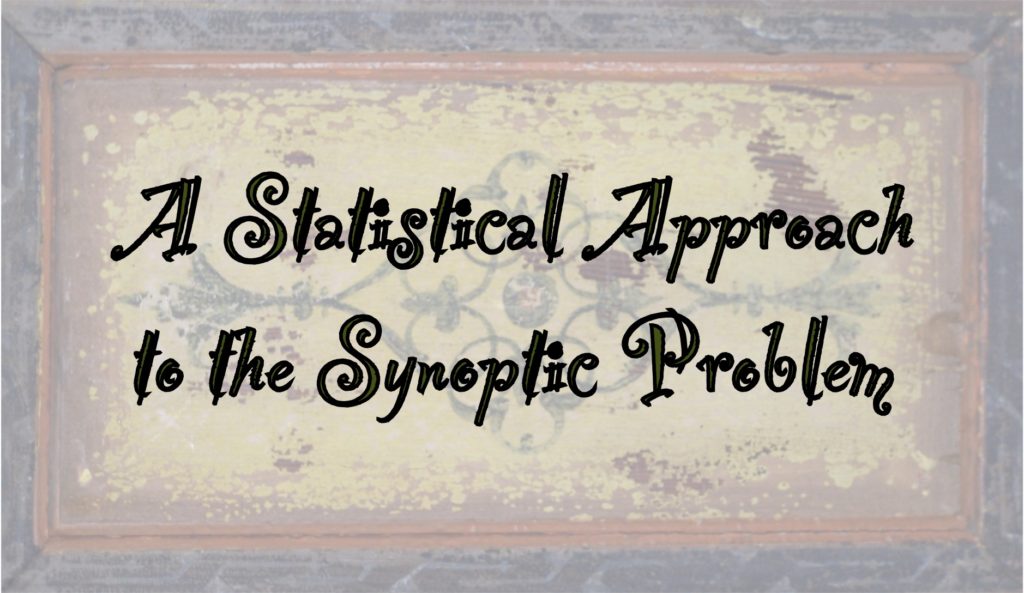
This article aims to contribute to the body of empirical data—particularly in the matter of the thousands of words involved in the “minor agreements” between the Gospels of Matthew and Luke against the Gospel of Mark—which must be accounted for by any viable theory that attempts to describe the interrelationships between the Synoptic Gospels, the so-called Synoptic Problem. It should be clear why the Synoptic Problem has become such a battleground:[1] Whatever solution is adopted will have tremendous influence on Gospel scholarship, all the way from textual criticism to the attempts to summarize the theologies of the respective Gospels.[2] With stakes that are so high, it is important to analyze the available data on an objective empirical basis. To that end, I have developed and adapted several new methods of quantifying and testing synoptic theories. The method I will discuss here is to evaluate all the options of linear dependence between three authors. Only six theoretically possible options exist, and the question to be asked is whether any of the options can stand up to objective empirical analysis or whether they all fail the test.
Six Theoretical Options of Linear Dependence
Theoretically speaking, it is possible that no literary dependence among the Synoptic Gospels exists at all.[3] On the other hand, all kinds of complicated schemes of interdependence are theoretically possible. Even in the case of linear dependence, the simplest of the hypothetically possible schemes of interdependence, it is theoretically possible that only two of the gospel writers had some literary relationship and the third was completely independent of the other two. The method I will discuss here is intended to test out the viability of the various schemes of linear dependence in which all three authors are involved, of which there are six theoretically possible relationships:
- Matthew→Luke→Mark
- Mark→Luke→Matthew
- Luke→Matthew→Mark
- Mark→Matthew→Luke
- Luke→Mark→Matthew
- Matthew→Mark→Luke
Paid Content
Premium Members and Friends of JP must be logged in to access this content: Login
If you do not have a paid subscription, please consider registering as a Premium Member starting at $10/month (paid monthly) or only $5/month (paid annually): Register
One Time Purchase Rather Than Membership
Rather than purchasing a membership subscription, you may purchase access to this single page for $1.99 USD. To purchase access we strongly encourage users to first register for a free account with JP (Register), which will make the process of accessing your purchase much simpler. Once you have registered you may login and purchase access to this page at this link:
- [1] This has become all the more clear from the analyses of Stoldt and Meijboom. They wrote independently, and a century apart from one another, yet they agree amazingly on the role of David F. Strauss as scaring people into Markan Priority. See Hans-Martin Stoldt, History and Criticism of the Marcan Hypothesis (Macon, Georgia: Mercer University Press, 1980), 227-235; H. A. Meijboom, History and Critique of the Origin of the Marcan Hypothesis1835-1866, (trans. John J. Kiwiet; Macon, Georgia: Mercer, 1993), 9-11. ↩
- [2] Presently all critical editions of the Greek New Testament text which are in common use are products of text critical scholars who accept the theory of Markan Priority. An example of this, noted by David Flusser, is the insertion of the notion of ascension into the text of Luke 24:51 from Mark 16:19 on the biased judgment call that certain papyri, which include the ascension phrase, outweigh all the other texts, which omit the phrase. The old Nestle text did not have this bias at this point; it did not include the phrase about ascension in its text of Luke. This Markan priority bias also artificially creates a conflict between this supposed ascension in Luke 24 and the fuller account in Acts 1 which takes place after forty days. Reuben Swanson has published a new critical edition based on an existing historical document, Codex Vaticanus, with all the variants presented in the apparatus. See Reuben Swanson, New Testament Greek Manuscripts: Variant Readings Arranged in Horizontal Lines Against Codex Vaticanus (4 vols.; Sheffield: Sheffield Academic Press, 1995). Of course, no text will be free from the bias of its editor(s), but there is no good reason why theorists who question Markan Priority should be forced to work from a text already biased in that direction. ↩
- [3] See Eta Linnemann, Is there a Synoptic Problem? (Grand Rapids: Baker, 1992). ↩
































































































Comments 2
Hello, how can I get a copy of Huck’s synoptic book. I bought one from amazon but it was really hard to read. print is very small.
Thank You
If you don’t mind using an electronic version, you can find Huck’s Synopsis on the Internet Archive, which would allow you to zoom in as much as you need (https://archive.org/details/huckssynopsisoff00huckrich). If you don’t need the Greek text, you could use Throckmorton’s Synopsis (https://archive.org/details/gospelparallels00thro/mode/2up), which uses the same pericope numbers as Huck.